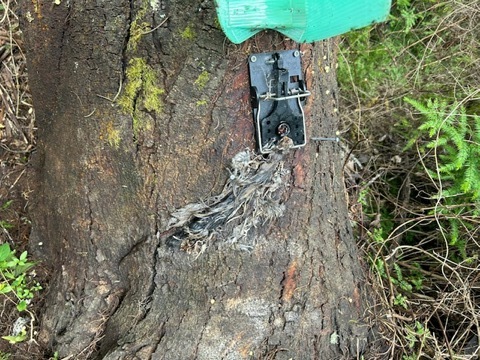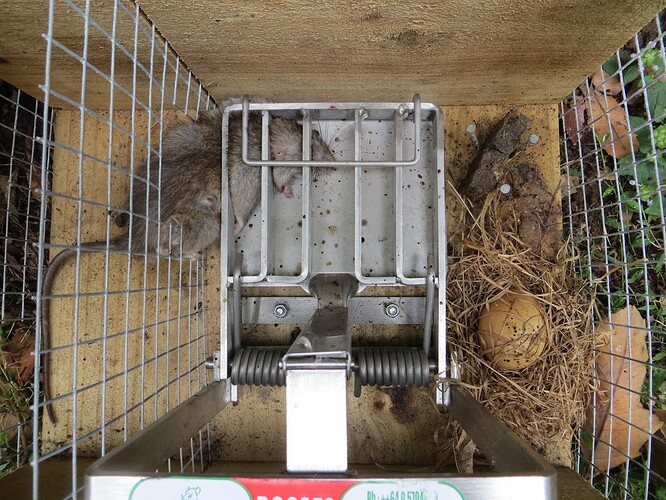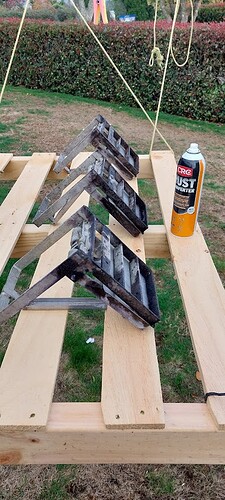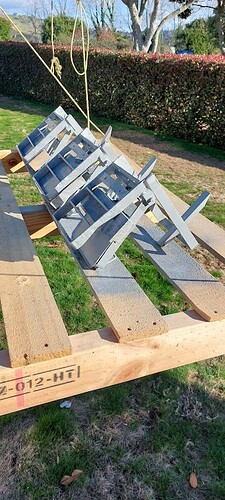I run a project in urban Auckland and use rat and possum traps. I had discounted using stoat traps as I was under the impression they weren’t common around urban/suburban areas. I assume the habitat could likely support them? the reason I bring it up is one of our members thought they saw a stoat and had the exact same thought as me until they saw it. Even then would the extra $150 dollars be worth it when they may may be in numbers too low to catch/control enough to make any kind of substantial difference? I’m curious to here opinions and experiences. -cheers Dan
Hi dan, perhaps your project could buy a few tracking tunnels and/or chew cards - check out the Predator Free NZ website for more about these.
This would be the way to know if you have a stoat problem or not before you make the bigger investment in DOC200s. Stoats are in much lower densities than rats, though, so you will need to have maybe 30 - 100 cards out for whatever amount of time PFNZ says (keep a list of where they all are, or set up a monitoring line in TrapNZ? ![]() )
)
Various sellers sell chew cards in varying quantities or you can make your own if you can get hold of corflute, the stuff Real Estate signs are made of.
Tracking tunnels are a little more expensive but perhaps easier to interpret the results.
I have experience with the above but I fear they would be around in numbers far too low to detect or catch, so the question I’m sort of wondering is if anyone knows if they are actually around in numbers too low to detect but high enough to merit a stoat trap. I guess the benefit of a doc200 is it also works on rats so it wouldn’t be a total loss if no stoats were caught but still the price tag definitely makes me question if its necessary. I do have access monitering tools like cameras but I fear them and any Doc-200s may be a risk of being stolen or wasted.
Yeah, you probably want to budget as much for security (s/s boxes, s/s “zip ties” and/or chains, security screws and bolts, etc.) as for the trap itself. Yay.
Humans are sad beggars. The project I’m on has a couple of traplines along roads, and a couple more on public tracks, and DOC200s and 250s seem to disappear at a steady rate despite being pegged down. Goodness knows what the thieves do with them.
If you can keep them, DOC200s should last basically forever since they are stainless steel. An heirloom! ![]() The cost might not be so bad if they last you 50 years.
The cost might not be so bad if they last you 50 years.
Edit: our project is rural, and we get about 1 stoat for 20 rats. I’d expect it to be more like 1 to 100 in urban areas because there is so much more food for rats. I don’t know if that helps.
Edit 2: more like 1:15.
I’m not sure you can really detect stoats via monitoring. You’d need meat based, or at least meat smelling lures and they often don’t enter tunnels.
I think many larger projects just assume the stoat population goes up with rat numbers. So, you monitor for rats and then use those numbers to estimate the stoat population
Cameras would be better, but I hear you re them getting pinched.
Kia ora Dan.
A trail camera may be a better investment.
Then you can determine whether you have stoats or weasels and get an idea of the population.
Good luck.
Like rats - they seem quite happy to live around a residential environment. Residents in our rural/residential street see them and trap them occasionally. I have trapped two ferrets and a stoat in my garden along with a large number of rats. Ferrets in Fenn6, stoat in doc250 and rats in Snap-e and Victor pro.
I have trapped a local Park for ten years – we got big numbers of all animal types early on but have now worn them down to low numbers and just getting a few each week now. We have killed a few stoats and weasels in Kness Snap-e traps – recently using GN meat lovers lure.
Don’t under-estimate the killing power of a Snap-e or a Victor pro trap – maybe not NAWAC approved for stoats or weasels – but if that is the bi-catch in your rat trap systems, then it is a low-cost bonus.
We just got 30 Connovation wooden trap tunnels at $30 each to upgrade my open core flute tunnels – I can make them for less than half that price using selected clean fence palings from ITM. If you use a Victor pro or a Kness Snap-e trap – you have a very economical rat/stoat trapping system.
There is little doubt that stoats are less likely to enter a wooden tunnel than an open core flute tunnel that I have used for years in the bush – but a friend (on this site) who operates wood tunnels in high country areas still catches large numbers of stoats and weasels.
When I started trapping in the local Park – we purchased a range of trapping equipment including five stainless doc250 traps. I pulled them out of service a few months back and replaced them with shiny new ones from Connovation – the difference in power between a new trap and a ten year old trap that has been continuously loaded is amazing. Stainless traps bolted to a tanalised timber box will always start to rust from the bottom up – I ground them down to clean steel, “killed” the rust, primed and repainted them – a lot of work but maybe good for a few more years. Even stainless steel goes rusty!

Hi. Tracking tunnels will definitely show what sort of pests you have, but you need to bait them with meat type lures such as erayze or good nature blood.
It might be more likely that you have weasels than stoats in town: I have trapped quite a few around Christchurch. I would recommend the DOC 200 or 150 for that: the smaller traps might get some, but there will be a few that get away and they will never go near a trap again, and teach their young to avoid traps too.
If you use DOC200 or 150 traps around town, then you’ll have mice eating the baits: LureGard from traptools.co.nz will stop the baits being taken.
What type of rat trap are you using, @dan_percy? Some traps like the modified Victor trap can be used for rats and mustelids. I looked on one website and it looks like they have a much lower price tag than DOC200s!
Modified Victor Stoat and Rat Trap (traps.co.nz)
Personally I’m a fan of monitoring tunnels - I put out my mustelid cards the day I pull in my rodent cards, since the tunnels have been nicely scented by any rodents and will therefore be more interesting to the mustelids! You can get frozen rabbit meat from most pet shops to use as lure. It doesn’t prove that stoats/weasels aren’t there, but might show you if they are.
Some projects use baiting rather than traps for their rats in order to target mustelids via secondary poisoning when they predate the rats. However, if you are in an area with lots of pets, or with native birds of prey, the risks of this approach could outweigh any benefits.
Another consideration for the DOC200s is whether your area has hedgehogs? If so, you can reduce hedgehog numbers and still be ready for any stoats or weasels that may wander through in a search for new territory - since they go to all the trouble of swimming from the mainland to the Hauraki Gulf islands, I’d expect that they probably make it to your area too.
A very good way to trap mustelids is to use both snap traps and DOC tunnels. When you kill a rat in a snap trap or the DOC trap, use the rat as a lure in the DOC tunnel. Using dead mustelids in tunnels as a lure is also a very effective way to trap other mustelids. You have to be careful to remove rats and mustelids from tunnels before they decompose too much, though.
One thing to remember about the cost of DOC traps and tunnels, is that they’re a long-term investment. It takes a long time for the springs of DOC traps to weaken to the point that it’s no longer humane to use them, and they require little maintenance. A stainless-steel DOC trap can be effective for a decade or longer, depending on how much activity in experiences, so the cost per year is small. Tunnels have to be replaced eventually, but they also last for a long time.
While they’re cheap, snap traps can break easily, and their springs weaken much faster than DOC traps. Over the past 6 months, I’ve had to retire 5 T-Rexes because they’ve either broken, or they were no longer humane.
Cheers.
Many good comments above, and adding one point I’ve not read above based on observations on our trapping lines around Westport. Unfortunately no camera footage to back up this theory.
We are trapping generally rats and stoats in DOC150/200s and several times have found rat bodies where the skull has been deliberately chewed open and brain tissue was gone. Suspecting this fatty tissue is much liked by stoats.
Therefore, finding similar trapped rats with open skull might indicate you have mustelids around, adding information without needing resources for cameras / monitoring tunnels etc.
I once read a story that an Irish farmer once found his pastures littered with rabbit corpses, but there wasn’t an obvious cause of death. Upon closer inspection, he found a small hole at the base of the rabbits’ skulls and the brains had been eaten. One or more stoats had been going on a killing spree, only eating the rabbits’ fatty, nutritious brains.
When killing or scavenging rats, mustelids will definitely eat fatty tissues first.
Hi unless you have something rare in the area that is really at risk from stoats then unless you start seeing some evidence don’t worry about them, there is a proven method for monitoring stoats good enough to get the Kokako recovery group tick of approval so forget about tracking tunnels, rats and the local Cats will go for your meat lure in tracking tunnels anyway.
There would be more benefit from targeting feral cats but that is probably a NO, I watched a video from a group in an Auckland reserve where Cats were climbing trees to raid nests.
you could slowly upgrade traps to DOC or BT 150’s dependent on placement possible thief etc, but only buy the stainless ones.
Remember the main prey for Stoats is Rats and rabbits as your rat numbers come down you have less food source for stoats. People might bleet on about stoats prey switching which can happen in some situations like mast years but really your reduction in rat numbers by trapping will be slow and stoats probably won’t breed with low food supplies, plus they have a short life of a year or two, a Fantail is not much of a meal compared to a big fat rat or a rabbit
I would say seeing as it sounds like you have limited funds stick with the Rats and Possums unless there is a reason to change, good luck with your project
cheers



